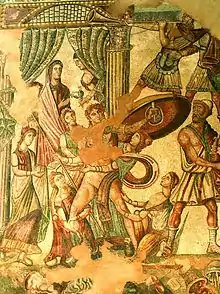Roman mosaic
A Roman mosaic is a mosaic made during the Roman period, throughout the Roman Republic and later Empire. Mosaics were used in a variety of private and public buildings.[1] They were highly influenced by earlier and contemporary Hellenistic Greek mosaics, and often included famous figures from history and mythology, such as Alexander the Great in the Alexander Mosaic. A large proportion of surviving examples come from Italian sites such as Pompeii and Herculaneum, as well as other areas of the Roman Empire.
.jpg.webp)
Development
.jpg.webp)
.jpg.webp)
The earliest examples of Roman mosaic flooring date to the late Republican period (2nd century BC) and are housed in Delos, Greece. Witts claims that tessellated pavements, using tesserae, were used in Europe from the late fifth to early fourth centuries BC.[2] This is contradicted by Ruth Westgate, who contends that the earliest tessellated mosaics of the Hellenistic period date to the 3rd century BC, with the 2nd to early 1st-century BC mosaics of Delos constituting roughly half of the known examples.[3] Hetty Joyce and Katherine M. D. Dunbabin concur with this assessment, asserting that the transition from pebble mosaics to more complex tessellated mosaics originated in Hellenistic-Greek Sicily during the 3rd century BC, developed at sites such as Morgantina and Syracuse.[4][5] The earliest known pebble mosaics and use of chip pavement are found at Olynthus in Greece's Chalcidice, dated to the 5th to 4th centuries BC, while other examples can be found at Pella, capital of Macedon, dated to the 4th century BC.[6][5]
The earliest mosaics of Roman Pompeii, dated to the Pompeian First Style of wall painting in the late 2nd and early 1st centuries BC, were clearly derived from the Hellenistic Greek model.[7] However, they contained far more figured scenes on average, less abstract design, the absence of lead strips, as well as an almost complete lack of complex, three-dimensional scenes utilizing polychromy until the Pompeian Second Style of wall painting (80-20 BC).[8][7] The mosaics in the Villa Romana del Casale (c. 300 AD) from Roman Sicily perhaps represent the hallmark of mosaic art in the Late Imperial period. The mosaic decoration of the local palace complex culminates in the gallery, which contains a scene of animal hunting and fighting covering an area of 3,200 square feet (300 m2).[9]
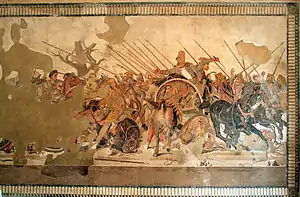
Technology
.jpg.webp)
Roman mosaics are constructed from geometrical blocks called tesserae,[10] placed together to create the shapes of figures, motifs and patterns.[2] Materials for tesserae were obtained from local sources of natural stone, with the additions of cut brick, tile and pottery creating coloured shades of, predominantly, blue, black, red, white and yellow.[2] Polychrome patterns were most common, but monochrome examples are known.[11] Marble and glass were occasionally used as tesserae,[12] as were small pebbles,[13] and precious metals like gold.[14] Mosaic decoration was not just confined to floors but featured on walls and vaults as well. Traces of guidelines have been found beneath some mosaics, either scored into or painted onto the mortar bedding. The design might also be pegged out in string,[2] or mounted in a wooden frame.[15]
The collapse of buildings in antiquity can, paradoxically, both irrevocably destroy mosaics or protect and preserve them.[2]
Imagery
As well as geometric patterns and designs, Roman mosaics frequently depicted divine characters or mythological scenes.[16][17]
Portraits
Imagery of famous individuals or entertaining scenes are common on Roman mosaics. The Alexander Mosaic from the House of the Faun, Pompeii depicts the Battle of Issus between Alexander the Great and Darius III.[18] In addition to famous people from antiquity, mosaics can depict aspects of daily life. The Gladiator Mosaic from Rome depicts a fighting scene, naming each gladiator involved. A gladiatorial scene is also known from Leptis Magna.[19]
Religion
One of the earliest depictions of Roman Christianity is a mosaic from Hinton St Mary (in Dorset, England) which shows Christ with a Chi-Rho behind his head. The mosaic is now in the British Museum.[9] Orpheus mosaics, which often include many animals drawn by the god's playing, are very common; he was also used in Early Christian art as a symbol for Christ. Scenes of Dionysus are another common subject.
Emblems
Progression within the mosaic technique developed the emblem, the "heart" of all mosaics. The word emblem is used to describe a small mosaic featuring a little genre scene or still life, characterised by particularly thin tesserae made separately and mounted in a central or important position in the main panel.
Archaeology
In May 2020, the discovery of a well-preserved Roman mosaic floor dating to the 3rd century AD buried underneath a vineyard at Negrar is reported after about a century of searching the site of a long-lost villa.[20][21][22]
Notable examples
- The Alexander Mosaic from the House of the Faun, Pompeii.
- The Tomb of the Julii in the Vatican Necropolis, beneath St. Peter's Basilica, Rome.
- The Gladiator Mosaic from the Via Casilina outside Rome.
- The Zliten Mosaic from Zliten in Libya.
Gallery
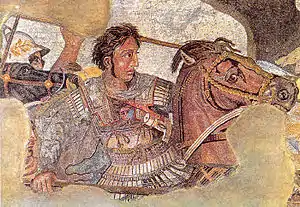
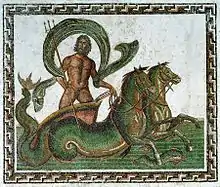 Neptune driving his chariot
Neptune driving his chariot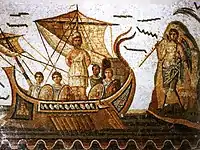 Ulysses during his journey
Ulysses during his journey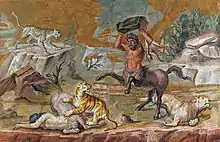
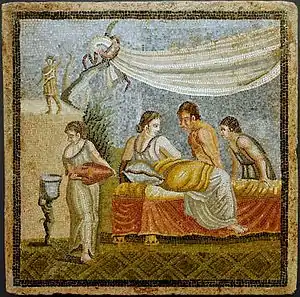 Love scene, 1st century
Love scene, 1st century Comedy Mask
Comedy Mask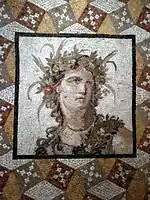 Antioch Mosaic
Antioch Mosaic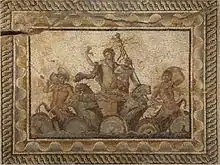 Epiphany of Dionysus mosaic, from the Villa of Dionysus (2nd century AD) in Dion, Greece. Now in the Archeological Museum of Dion.
Epiphany of Dionysus mosaic, from the Villa of Dionysus (2nd century AD) in Dion, Greece. Now in the Archeological Museum of Dion.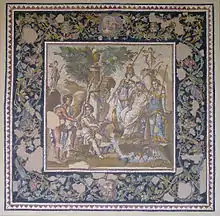 Judgment of Paris, marble, limestone and glass tesserae, 115–150 AD; from the Atrium House triclinium in Antioch-on-the-Orontes
Judgment of Paris, marble, limestone and glass tesserae, 115–150 AD; from the Atrium House triclinium in Antioch-on-the-Orontes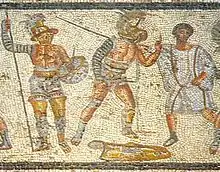 The Zliten mosaic showing gladiators, 2nd century AD
The Zliten mosaic showing gladiators, 2nd century AD
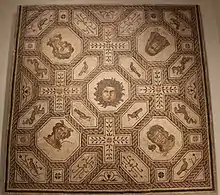 A mosaic showing Medusa and representational figures of the four seasons, from Palencia, Spain, made between 167 and 200 AD
A mosaic showing Medusa and representational figures of the four seasons, from Palencia, Spain, made between 167 and 200 AD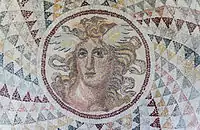 A Roman mosaic from Piraeus depicting Medusa, using opus tessellatum, 2nd century AD, National Archaeological Museum of Athens
A Roman mosaic from Piraeus depicting Medusa, using opus tessellatum, 2nd century AD, National Archaeological Museum of Athens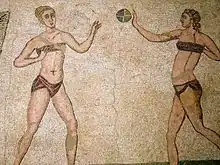 Mosaic of female athletes playing ball at the Villa Romana del Casale of Piazza Armerina, 4th century AD
Mosaic of female athletes playing ball at the Villa Romana del Casale of Piazza Armerina, 4th century AD.JPG.webp)
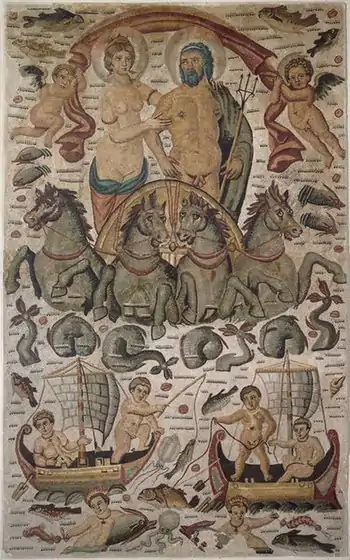 Triumph of Poseidon and Amphitrite showing the couple in procession, detail of a mosaic from Cirta, Roman Africa, 315–325 AD, Louvre
Triumph of Poseidon and Amphitrite showing the couple in procession, detail of a mosaic from Cirta, Roman Africa, 315–325 AD, Louvre Paleochristian mosaic from Santa Pudenziana in Rome, c. 410 AD
Paleochristian mosaic from Santa Pudenziana in Rome, c. 410 AD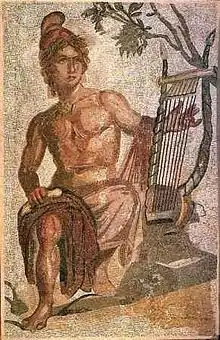 Mosaic of Orpheus from Caralis, modern Cagliari (Italy), now in Archeological Museum of Turin
Mosaic of Orpheus from Caralis, modern Cagliari (Italy), now in Archeological Museum of Turin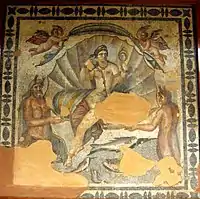
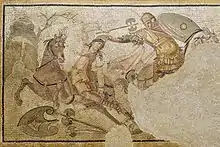
See also
References
- Bertoldi 2011.
- Witts 2005.
- Westgate (2000), pp. 255-256.
- Joyce (1979), p. 260.
- Dunbabin (1979), p. 265.
- Joyce (1979), pp. 259-260.
- Westgate (2000), pp. 255-275.
- Joyce (1979), pp. 253-254, 257-258.
- "The Hinton St Mary Mosaic". British Museum. 2015. Retrieved 19 February 2015.
- Dunbabin 2006, p. 280.
- Packard 1980.
- Ricciardi et al. 2009.
- Donaldson 1965.
- Neri & Verità 2013.
- Oliver 2001.
- "Physical Aspects of the Polytheistic Roman Style". Tufts University. 2005. Retrieved 13 March 2015.
- C., Rawan (11 March 2015). "Roman Mosaic Discoveries Made Through Time". Mozaico. Retrieved 13 March 2015.
- Knox, E.L. Skip. "Alexander the Great - The Battle of Issus (334)". History of Western Civilization, Boise State University. Archived from the original on 25 March 2015. Retrieved 13 March 2015.
- "Roman mosaic found in Libya". News24. 14 June 2005. Retrieved 21 February 2015.
- "Ancient Roman mosaic floor discovered under vines in Italy". the Guardian. 27 May 2020. Retrieved 8 September 2020.
- "Roman mosaic floor found under Italian vineyard". BBC News. 27 May 2020. Retrieved 8 September 2020.
- "Perfectly preserved ancient Roman mosaic floor unearthed beneath Italian vineyard". www.cbsnews.com. Retrieved 8 September 2020.
Sources
- Bertoldi, Susanna (2011). The Vatican Museums: discover the history, the works of art, the collections [I Musei Vaticani: conoscere la storia, le opere, le collezioni]. Sillabe. ISBN 978-8882712105.
- Donaldson, M. Katherine (1965). "A Pebble Mosaic in Peiraeus" (PDF). Hesperia: The Journal of the American School of Classical Studies at Athens. 34 (2): 77–88. JSTOR 147018.
- Dunbabin, Katherine, M. D. (1979), "Technique and Materials of Hellenistic Mosaics", American Journal of Archaeology, Archaeological Institute of America, 83 (3): 265–277, doi:10.2307/505057, JSTOR 507451.
- Dunbabin, Katherine M. D. (1999). Mosaics of the Greek and Roman world. Cambridge University Press. ISBN 978-0521461436.
- Joyce, Hetty (1979), "Form, Function and Technique in the Pavements of Delos and Pompeii", American Journal of Archaeology, Archaeological Institute of America, 83 (3): 253–263, doi:10.2307/505056, JSTOR 505056.
- Neri, Elisabetta; Verità, Marco (2013). "Glass and metal analyses of gold leaf tesserae from 1st to 9th century mosaics. A contribution to technological and chronological knowledge". Journal of Archaeological Science. 40 (12): 4596–4606. doi:10.1016/j.jas.2013.07.017.
- Oliver, Andrew (2001). "A Glass Opus Sectile Panel from Corinth" (PDF). Hesperia: The Journal of the American School of Classical Studies at Athens. 70 (3): 349–363. JSTOR 3182066.
- Packard, Pamela M. (1980). "A Monochrome Mosaic at Isthmia" (PDF). Hesperia: The Journal of the American School of Classical Studies at Athens. 49 (4): 326–346. JSTOR 147913.
- Ricciardi, Paola; Colomban, Philippe; Tournié, Aurélie; Macchiarola, Michele; Ayed, Naceur (2009). "A non-invasive study of Roman Age mosaic glass tesserae by means of Raman spectroscopy". Journal of Archaeological Science. 36 (11): 2551–2559. doi:10.1016/j.jas.2009.07.008.
- Westgate, Ruth (2000), "Pavimenta atque emblemata vermiculata: Regional Styles in Hellenistic Mosaic and the First Mosaics at Pompeii", American Journal of Archaeology, Archaeological Institute of America, 104 (2): 255–275, doi:10.2307/507451, JSTOR 507451.
- Witts, Patricia (2005). Mosaics in Roman Britain: Stories in Stone. Stroud: History Press. ISBN 978-0752434216.
External links
| Wikimedia Commons has media related to Ancient Roman mosaics. |
| Library resources about Roman mosaic |
